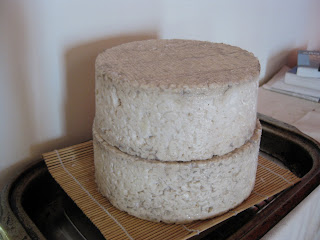
These are some photographs from the procedure of making
St. Nectaire. I based my procedure on the description of the making of this cheese by Patrick Rance. On page 217 in his book " The French Cheese Book" he describes a visit in 1973 to the farm of Madame Fereyrol in Chandeze, just outside Besse.
She started making cheese at 6.30 a.m. with about 25 gallons of milk from the thirty seven Salers cows. The milk was renneted at once at 31C (33C in winter) and coagulated in 45 minutes at which point she started to cut the curd. For the cutting Madame Fereyrol used a menole. After some research, I came across a frenhau. This is the traditional tool of cutting the curd for Cantal cheese. Both cheeses being from the Auvergne, I figured that the curd cutting tools must be fairly similar. I made mine after the images I found online.
Patrick Rance describes how Madame Fereyrol worked her menole slowly up and down through the curd until a uniform cut of mais sized grains was established. The temperature of the curd needs to be kept at least up to renneting temperature. Madame Fereyrol brought hers op to 35C by introducing water at 40-45C. Adding warmer water might seal up the curd and prevent whey expulsion.
She then stirred the curd to firm up the grains. The description doesn't mention a time, but in my experience, this usually takes around 40 minutes. The curds then settled on the bottom of the vat for a few minutes after being brought together with a
menadou (also called a
musadour or
mouisadou). I haven't figured out how to use a tool like this although I have seen some films showing the use of it. The implement is gently taken round the sides of the vat to pile up the curd and encourage it to mass together. This takes usually 10 minutes according to Rance. At this point the
pousset or
puise-serum, an upside down mushroom, is used to press down the curd and remove most of the whey.
I use a large lid to press down the curd and expel some whey. The whey I remove from the vat with a saucepan. In time I shall make a menadou or mousadour.
The curd is now cut into cubes, 10 centimeters, and distributed between the cheese moulds. She pressed the curd down by hand into the shallow moulds, gently at first, gradually more firmly. Patrick Rance then describes how Madame Fereyrol put the cheeses into deeper moulds under a lever-and -counter-weight press for one minute on each face. She then applied casein marking plaques and salt on each face. She applied 25 grams for each cheese while The Syndicat suggest 30 grams. Here Patrick Rance makes one of his numerous comments about salt in cheese. He says: "...and I am all for moderation".
The cheeses are then pressed for eight to twelve hours before turning and pressed again for the same amount of time.
The two batches of cheese based on this procedure I made recently did deviate from the recipe.
The moulds I used were larger than the traditional ones used and I brine salted the cheeses. In du time, I shall try to stay closer to the recipe and try to make a traditional St. Nectaire.








































